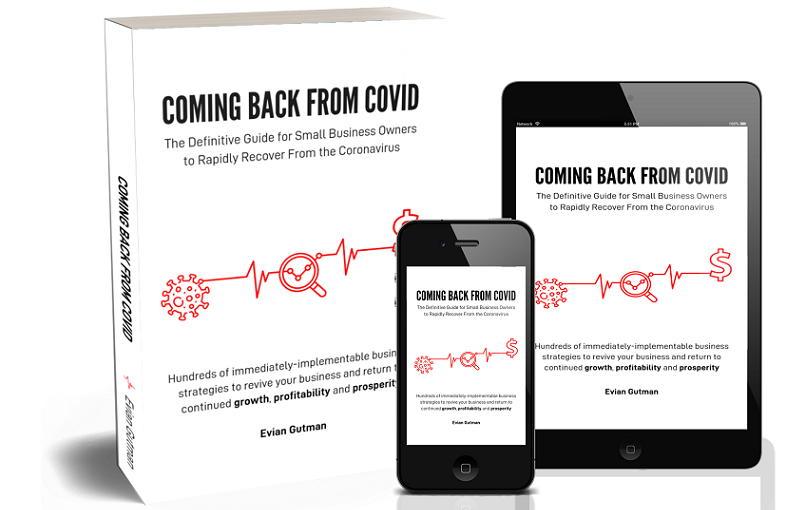Based in Australia, Evian Gutman is the founder of two startups — Padlifter and Ringcommend. He was earlier a management consultant and digital marketing head. He is the author of Coming Back from COVID (see my book review here).
The book provides 300 business recovery tips for small businesses in six categories — people, operations, product, marketing and sales, growth, accounting, and finance. In this chat with YourStory, Evian talks about the journey of an entrepreneur, resilience beyond the pandemic era, digital transformation, and ecosystem support for entrepreneurship.
Edited excerpts from the interview:
YourStory [YS]: What are the top three contributions digital technology is making to businesses in the pandemic era?
Evian Gutman [EG]: I like to consider myself a big fan of digital technologies for a wide range of reasons. However, I always try to temper my excitement by reminding myself that at the end of the day, technology itself is just a tool (albeit a powerful one!).
With that being the case, the ability to effectively leverage technology is equally-reliant on how cutting-edge technologies are utilised, as much as the sophistication of the technology itself.
Thus, in the post-COVID world, there are several key benefits afforded by digital technology.
Firstly, technology provides internal opportunities to optimise the efficiency of business operations. This can take multiple forms like new machinery that produces products at faster speeds or lower costs, or improved systems and processes that allow for better and faster communication patterns and decisions.
Secondly, digital technology enables businesses of all sizes to scale their offerings on a global scale and provide access to global markets previously unavailable. Ecommerce means that all businesses now have a theoretical global footprint to anywhere in the world that has an internet connection, as well as cost-effective digital marketing tactics that create new sales channels that can be accessed with the click of a button.
Thirdly, digital technologies prevent businesses from ‘flying blind.’ The COVID-19 pandemic created a lot of question marks and uncertainty. In contrast, digital technologies remove uncertainty by improving the visibility afforded to businesses over almost every function of their business.
These days, there aren’t many things that cannot be tracked and measured. Whether we’re talking about the output efficiency of production processes or the effectiveness of a given online marketing campaign; modern business owners and operators have no shortage of data-driven, evidence-based methods for validating the effectiveness of their efforts and investments, and preventing them from wasting time and money by going down wrong paths as early as possible.
YS: What are the typical challenges entrepreneurs face as they scale from startup to growth stage? How can these challenges be addressed?
EG: Being a startup entrepreneur involves wearing many hats. Today, you might be developing the go-to-market strategy for your latest product release. Tomorrow, you might be the hiring manager responsible for doubling the size of your team. And the day after that, you may be the one raising funds to guarantee that your business lives to experience another spin around the sun. It’s an exciting, but tumultuous journey!
As a startup grows, one of the most challenging things for entrepreneurs is ceding responsibility for the wearing of all of these hats. What made you successful yesterday runs the risk of exhausting you to die tomorrow. And as the size of your startup grows, it becomes untenable to continue wearing all of these hats and executing all of the functions that you previously once did.
Savvy entrepreneurs will need to surround themselves with talented and trusted individuals who are equally (if not more so) capable of carrying out the core business functions necessary for creating a sustainable high-performing business.
This challenge is not easy and will make many entrepreneurs feel uneasy at the beginning. However, by focussing on repeatable processes that capture best practices and executed by talented team members, the business will be in a formidable position to continue growing and taking advantage of all opportunities as they continue to present themselves.

YS: How should innovators strike that delicate balance between ‘Stick to your vision’ and ‘Adapt to a changed world?’
EG: In the absence of having a crystal ball, even the best of plans have their innate limitations. What this means is that it is incumbent upon entrepreneurs to remain dynamic to their ever-changing realities. What was a good idea yesterday might be a bad idea tomorrow, and vice-versa. Nonetheless, this doesn’t mean that entrepreneurs should take shortcuts or ignore their planning obligations.
They need to diligently invest in developing exhaustive plans that are comprehensive in the details. They need to proceed on the assumption that their plans are robust and represent a formidable approach for capitalising on identified opportunities. However, they must simultaneously be testing their assumptions and remain open to adapting the plan as new and better information comes in.
With this approach, a virtuous cycle of continuous improvement is able to be developed, that appropriately reconciles the competing objectives of sticking to the vision while remaining adaptive to a changing world.
YS: Is there such a thing as the ‘ideal age’ for an entrepreneur, or can the startup bug strike you at any time? How should people keep themselves open to adopting an entrepreneurial career later in life?
EG: It’s my personal belief that people spend too much time getting fixated on strict definitions. There is no doubt that there are common characteristics of startup entrepreneurs. They tend to be ‘disruptors.’ They tend to focus on products that utilise new technologies in innovative ways. They tend to focus on scalable business models. However, there is no definitive ‘shopping list’ of what an entrepreneur needs to be doing to call themselves an entrepreneur.
Some entrepreneurs get their start in the startup game at the age of five, selling lemonade for a dollar a cup from the front yard of their parents’ house. Other entrepreneurs get into the game much later in life, after having built a sizable career as a subject-matter expert, working for many decades across ‘traditional’ businesses.
Neither makes one better than the other, and each carries respective pros and cons. What is most important to being an entrepreneur is having the fire in the belly for simply doing something better. And, this can come at any age.
People shouldn’t try ‘retrofit’ the entrepreneurial life onto their circumstances. It’s important to recognise that the entrepreneur’s life is not preferable to everyone; and that in many instances, entrepreneurialism is not always the optimal pathway to pursue.
However, for those to whom the entrepreneurial life resonates, it can seem like the natural, obvious, and only pathway of pursuit. Having a connection with a cause will fuel the drive that is necessary for overcoming the countless obstacles that stand between the vision and the outcome.
For entrepreneurs of all ages — both young and old — they should take an honest look in the mirror and ask themselves what they believe their strengths and weaknesses to be. For those that may be entering the game slightly later in life, this may mean surrounding themselves with individuals that can compensate for any personal skill deficiencies, or upskilling themselves in the requisite ways necessary for addressing any such identified gaps.
YS: It’s one thing to fail with a product, and a bigger dimension to fail with a company. How should founders regroup in these two situations?
EG: ‘Failure’ in the startup world is a dangerous term — what does it actually mean to ‘fail?’ Did you fail if your product launch didn’t hit its ambitious objectives? Did your company fail if your revenue targets weren’t hit? It’s important to contextualise ‘failure’ as a distinct phenomenon when discussed within the context of entrepreneurialism.
When growing a business, failure and audacity sit on the flip sides of the very same coin. Everything entails an element of risk, and no outcome is preordained for guaranteeing success. The only true failure is when this audacity is not backed up with research, due diligence, and a well-mapped out plan for execution.
Even when those elements are in place, you can be near-certain that at some point on your entrepreneurial journey to success, you will still encounter some element of ‘failure.’ But when tackled with humility, determination, and capability, you stand the best possible chances of developing the right strategies that saw you overcome past challenges too.
From a practical perspective, when product issues emerge, founders should look towards identifying the root cause of the issue. Is it a marketing issue? Is it a product-market fit issue? Is it an operational issue? Or is it a combination of all of these (and maybe others too)? This is best done by going direct to the market and validating directly with customers — both existing and potential.
There may also be times where you question the ongoing viability of your company. Is it worth pushing on? The answer to this question is not always straightforward. Sometimes a business may be viable, but the return on effort doesn’t justify what’s involved in continuing to pour your heart and soul into keeping it alive.
Where this occurs, founders should have an honest reflection on their personal feelings towards their reality. They should consider the ease and practicality of pivoting the business in a new — but more promising — direction. Again, all of these decisions need to be made within the context of considering alternative uses of time by the founder, which may potentially allow them to focus on other higher-yielding or more immediate and lucrative opportunities.
YS: How should founders evaluate weak signals and anecdotal evidence which seem to contradict quantitative market trends?
EG: Effective founders do not think about qualitative versus quantitative evidence as an either/or question. They are both important and work in complementary ways.
In an ideal world, your quantitative data points will support the anecdotal ‘word on the street.’ Sometimes there may be a misalignment, and sometimes there may be grades in between.
Instead of preferencing one over the other, use any misalignment as a trigger for further investigation. Why are you seeing and hearing conflicting reports? Why might consumer sentiment be suggesting a different story to what the numbers that are jumping off the page are telling? How effective are your data sources, and how extensively have you surveyed the market?
Instead of running away from the conflict, use it as an opportunity to refine and finesse your testing and validation methods. The most effective founders will inevitably be those that complement their comprehensive plans with a rigorous continuous improvement framework that draws on multiple sources of input and evidence to illuminate honest and accurate insights.
YS: What is your current field of consulting? What kinds of services do you offer?
EG: My professional background stems originally as a management consultant, with a focus on helping large blue-chip B2B organisations optimise their sales performance. Over time, I transitioned into a digital marketing role. Most recently, I combine these skill sets to help SMBs, which typically have less than 500 employees and annual revenue of less than $25 million, across a broad range of business improvement initiatives.
Many of the businesses I work with are established businesses. Because of this, I tend to focus on growth strategies that address underlying performance issues or leverage untapped opportunities. From my experience, this tends to fall within the broad categories of marketing and sales, product, growth, operations, team, and accounting and finance. For that reason, I also structured the book around those very same categories.

YS: How was your book received? What were some of the unusual responses and reactions you got?
EG: I think that it’s important to recognise that first and foremost, COVID-19 is a global health crisis, that has resulted in over one million deaths and left many more than that severely sick. With that being the case, we need to be respectful when talking about COVID within the paradigm of business and converting adversities into opportunities.
Within this context, the book has been well-received. In its first month alone, it was purchased by over 3,600 people. At its peak, it was ranked #1 on the Amazon Kindle Store for the categories of small business, starting a business, and business leadership.
Some people were surprised at how quickly the book was able to be written and published. One of the key themes that I try to emphasise throughout the book is that it is often in moments of crisis that ascendancy takes seed. I tried to apply that very principle to writing this book and making sure that it ended up in the hands of those that would benefit from it as soon as possible.
YS: In the time since your book was published, what are some notable new tips or initiatives you would suggest for business recovery?
EG: As an author, there’s always a fine line between packing your book with too much and too little information. On the one hand, you want to share everything you know in the hope that the more you tell, the more opportunities there are for someone learning something new. On the other hand, you want to limit the advice you dispense, so that the insights you do share are the crème de la crème — the things most likely to really ‘move the needle’ and make a material impact with the greatest of ease.
If there were one thing I would add to the book today, it is reinforcing the idea that coming back from COVID is about returning to time-tested business fundamentals and adapting them to the unique realities and challenges of our time. At the end of the day, more businesses will be better off doing a smaller number of things right, than a larger number of things wrong.
YS: Are there specific case studies you can cite that you think exemplify business recovery?
EG: I’m reluctant to cite specific companies that adapted well to the coronavirus crisis — not because they don’t exist (they very much do!), but because they don’t do justice to the tens of thousands of small businesses that may have been equally (if not more so) effective in overcoming the challenges of COVID, but without the spotlight necessarily having been shone upon them.
We are all familiar with many of the ‘poster boy’ companies that have done well throughout the COVID pandemic — how many people had used Zoom video-conferencing technologies before 2020? How many people increased their online purchases this year for groceries, clothes, and household essentials?
I believe the true “success stories,” however, are the small businesses that were quick to pivot without necessarily having the experience nor resources, for otherwise doing so.
As an example, many cafes and restaurants were forced to close for several months during government-mandated lockdowns. Instead of throwing their hands up in the air and lamenting their challenging reality, many decided to adapt and tweak their offering by introducing new and innovative take-away and/or delivery options. Once the lockdowns were lifted, a lot of these same restaurants kept these new offerings, having found that they represented lucrative new revenue streams (irrespective of COVID).
As another example, there is a small hardware business that I recently consulted. They ran a local area marketing campaign that promoted the idea of DIY (Do It Yourself) home improvement fixes. With lockdowns in place, limits on social gatherings, and more free time available, they promoted the idea that now was the perfect time to complete all those jobs that people had been meaning to get around to for a long time yet, never did. As a result of these marketing campaigns, 2020 turned out to be one of the most profitable years on record for this particular business.
YS: How can social entrepreneurs and non-profit organisations make use of your frameworks and tips?
EG: Over the last few decades, there has been a growing trend towards the professionalisation of the NFP (not-for-profit) sector. This should come as no great surprise (and ideally, should have come about much sooner!).
While the goals and KPIs of social entrepreneurs and NFP organisations might be different from the hard-dollar focus on ‘for-profit’ startups, many of the strategies for goal realisation remain nonetheless the same.
Even if what they are “selling” is not a product in the traditional sense of the word, they still have a clear-cut offering that needs to be effectively marketed, operationalised by an efficient organisation staffed with a capable team, and run in a financially-viable way.
For all of these reasons, the best thing a social entrepreneur can do is see themselves as cut from the same cloth as any other for-profit business leader.
YS: What are the top three success factors for government and industry to work together and sustain entrepreneurship in their countries?
EG: I believe that ‘internal’ communication, ‘external’ communication, and incentives/risk-sharing represent three of the biggest success factors for promoting government and industry to work together in sustaining entrepreneurship in their respective countries.
By ‘internal’ communication, I am referring to ‘intra’ communication between a particular industry and government. Forward-thinking industries will keep the government abreast of developments that stand to benefit the economy and society. Dangling these carrots in front of the government will help get them excited about opportunities, which will pave the way for the government to then feel comfortable in leading the charge and creating the conditions necessary for supporting relevant projects and initiatives.
While we often think of a ‘chicken-and-egg’ scenario between industry and government that has the potential to stagnate progress, there are many opportunities for industry to adopt a leadership role in directing the conversation and shepherding everyone onto the same page.
By ‘external’ communication, I am referring to marketing the wins to the general public. Government and industry have a powerful opportunity (and vested interest) in communicating the possibilities that can come through effective collaboration. Speaking in lockstep will not only illuminate these possibilities but also help mitigate any objections. In doing so, many of the roadblocks that stand in the way of progress and outcomes, will be cleared, enabling both parties to effectively promote these initiatives to the public.
Finally, there should be an element of incentivisation and risk-sharing by the government. Entrepreneurs put a lot on the line without much security or certainty of outcome. With that being the case, anything the government can do to alleviate any of this risk will be a welcomed gesture by industry and entrepreneurs.
This can come in many forms, though in its most explicit manifestation will come in the form of financial incentives. Loan guarantees, tax credits, cash-flow boosts, financial grants, and assistance are but some of the measures that government can offer to demonstrate their willingness to work with industry in shouldering some of the risk entailed in entrepreneurship.
YS: What is your next book going to be about?
EG: As much as I love helping businesses activate high-impact growth and stability strategies, I think that we’re all feeling an element of ‘COVID-fatigue’ right now. It seems like no matter which way you look, COVID is the topic of conversation one way or another — either directly or indirectly.
I’ve had some thoughts recently around how many of the pressing challenges we face on both an individual and global scale are driven by a narrow attachment to hard-and-fast rules, that imagine there is only one “right answer.” Such an approach is not always conducive to optimal outcomes and fails to recognise the legitimacy of alternative perspectives.
As they say, two plus two equals four, but so does three plus one. Two very different approaches can simultaneously yield equally-optimal outcomes, without necessarily discrediting the legitimacy of the other.
While I haven’t yet thought all of this through to its logical endpoint, I would like my next book to focus upon these ideas. I’d like to explore detaching ego from objectives, and utilising broad multi-disciplinary approaches for arriving at optimal outcomes. I believe that all of these ideas already resonate with the entrepreneur’s mindset and general approach to problem-solving too.
YS: What are your parting message to the startups and aspiring entrepreneurs in our audience?
EG: I’m a big advocate for taking a broad perspective on ‘success.’ If you ever zoomed in to a specific moment-in-time, and asked whether any startup or entrepreneurial initiative was “successful,” you would obtain a very incomplete answer to that question — what had taken place before, and what was likely to take place after? How many challenges have already been overcome, and how many more lie on the horizon? How scalable and repeatable are the successes, and how effectively have known obstacles been mitigated or extinguished?
All of these things matter.
It’s now become a bit of a cliché, but entrepreneurialism is a marathon — not a sprint. And, when you combine capable humans with that fire in the belly, and a solid offering for overcoming an identified problem, then you have a recipe for success and a good reason to believe that positive fortunes lie ahead for the entrepreneur, one way or another.
Edited by Suman Singh
India’s most prolific entrepreneurship conference TechSparks is back! With it comes an opportunity for early-stage startups to scale and succeed. Apply for Tech30 and get a chance to get funding of up to Rs 50 lakh and pitch to top investors live online.
Link : https://yourstory.com/2020/10/entrepreneurship-resilience-covid19-evian-gutman
Author :- Madanmohan Rao ( )
October 08, 2020 at 07:20AM
YourStory





